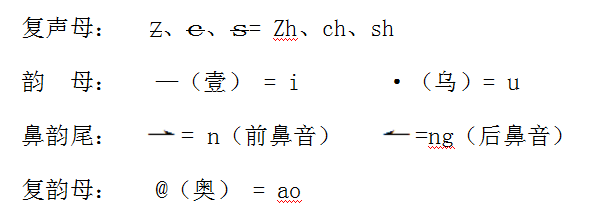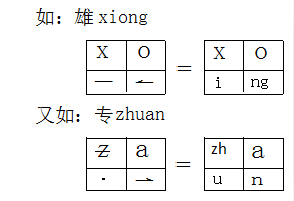Simply put:
(1) Some syllables have too many Pinyin letters, such as zhuang, which can not be compressed into 2 bytes at any rate, just like Chinese characters, so that they can be neatly labeled or synthesized into a font;
(2) It can solve many problems and ambiguities in the original Pinyin alphabet.
It's the simplest symbol. There are only five in all.
Instead of the alphabet, there are only 8:

It is to replace the phonetic form of the corresponding letters with the above abbreviations and become a binary way of both abbreviations and letters, such as:

In fact, it is also very simple, and the rhyme is always recorded below the preceding initial (underlined position).

Explanation: From the square, it can be seen that the rhyme and finals must be concise characters, and the underline position below, so that the advantages of concise characters can be fully utilized (not in bytes).
It is the combination of Pinyin and Chinese characters. The Pinyin here is the "simplified pinyin" mentioned above. This new type of Chinese characters has both Pinyin and Chinese characters. It can be called a veritable "phonetic Chinese character" or "phonetic Chinese character". For example:
Explanation: The above box has no real meaning, but only shows that "phonetic Chinese characters" still retain the block characteristics of Chinese characters.
According to the actual needs, the left and right positions of the original Chinese characters can be used, such as:
Simplicity is the absolute truth!
Honey, have you mastered the above in a few minutes?
Don't forget, the fee we charge for the lecture is: spare your precious few minutes to teach others, too! I'm sure your explanation will be easier to understand than ours. Thank you.